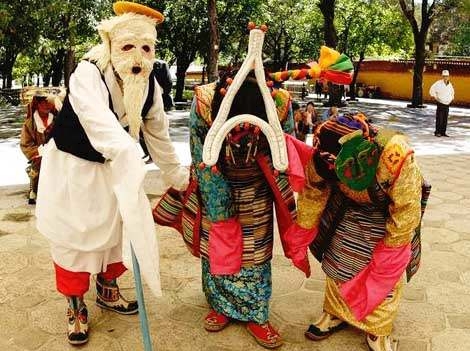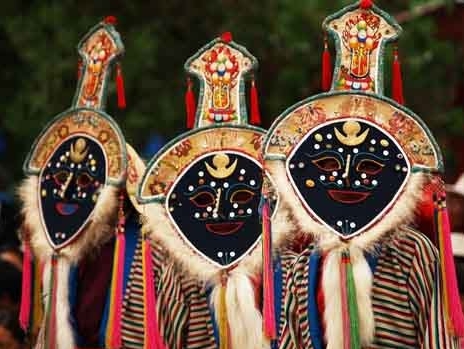
Called "ba" in Tibetan, masks are mainly used for various folk performing arts and have direct links with people's daily life, work and entertainment. They are popular across Tibet.
Masks used in Tibetan operas are developed from the masks worn by primitive mediumistic dancers and sorcerers at temples to drive away ghosts. The mask appeared in the early days of the formation of the Tibetan opera itself. The grand Tibetan opera performed in honor of the hero Songtsam Gambo recorded in The Reign History of Ancient Tibet is said to be the earliest documentation of Tibetan opera masks. The mask of Tibetan opera mainly features historical figures, mythological characters, immortals, ghosts and animals, all of which have unique characteristics. The images of immortals, ghosts and animals are usually personified.
There is a wide range of Tibetan opera masks in terms of the materials, such as wood sculpture, bronze image, paperboard, leather and cloth etc. The masks can be roughly divided into three categories according to the characters they represent. The first category is called "wenba", meaning fishermen or hunters. This is the most important mask type in Tibetan opera. They come in blue and white colors. White masks are made of white fleece and often in simple structures. They are relatively rough masks popular in the early days of the Tibetan opera. Blue masks are slightly bigger than white ones. They are in exaggerated styles, elaborately painted and beautifully adorned.
The second category is human figure masks, with different colors symbolizing different character features. Masks in this type are often in bright colors that contrast sharply with one another. The third category is animal masks, such as goat head, ox head, horse head and tiger head etc, with each animal representing a divine figure. These animal masks are commonly used in the lion dances and yak dances performed by Tibetan opera troupes in Ganzi of Sichuan Province.

Tibetan opera masks reflect the special living environment, folk customs and religious beliefs of Tibetan people. Along with the development of the times, the ghost and god worshiping nature of the mask have been watered down and stress has been put on their artistic and entertainment qualities. The masks have become the most distinctive opera handicrafts in Tibetan culture.